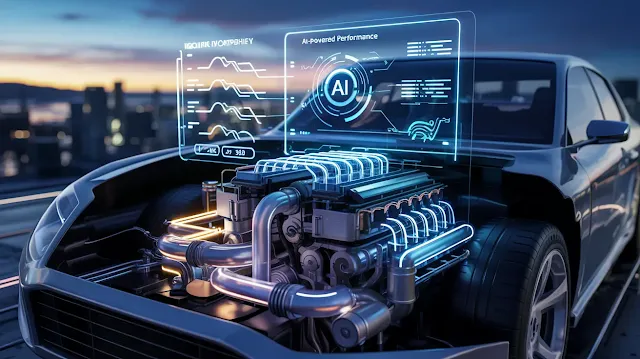Artificial Intelligence Inside the Car Engine: Redefining Modern Driving
Introduction: A New Era Under the Hood
Artificial intelligence (AI) is no longer limited to infotainment systems, or autonomous driving features. It's now integrated deep within the heart of your car the engine. This transformation is shaping a smarter, more efficient, and safer driving experience.
Data Processed by AI in Vehicles
Key Data Streams Fueling AI Decisions
AI systems inside vehicles collect and analyze vast data sets in real-time, including:
Sensor Data: Visual, auditory, and spatial data from cameras, LiDAR, radar, and ultrasonic sensors.
Performance Metrics: Engine load, torque, fuel efficiency, emissions, and temperature.
Driver Behavior: Braking patterns, acceleration habits, and steering dynamics.
External Environment: Road conditions, traffic patterns, weather data, and surrounding vehicle behavior.
These data sources help AI optimize performance and predict engine requirements more precisely.
AI and Automotive Manufacturing Efficiency
Lowering Production Costs Through Smart Automation
AI’s integration in manufacturing is reshaping how cars are built:
Automated Quality Control: AI-driven inspection systems catch microscopic defects.
Predictive Maintenance: AI predicts machinery failures before they happen, minimizing downtime.
Smart Logistics: Real-time data enhances parts inventory and supply chain accuracy.
As a result, manufacturers reduce waste and accelerate production without compromising quality.
Challenges of Applying AI to Car Engines
Barriers to Seamless Integration
Despite its potential, AI faces several roadblocks when implemented in engine systems:
High Development Costs: Building AI-powered engines requires significant investment.
Legacy Compatibility: Traditional engine frameworks aren't always AI-friendly.
Ethical Dilemmas: Programming decision-making in critical situations remains complex.
Lack of Industry Standards: No universal guidelines for AI deployment in engines.
These challenges need to be addressed for widespread adoption.
Enhancing Engine Efficiency and Reducing Fuel Consumption
Smarter Combustion and Energy Management
AI significantly boosts engine efficiency by:
Dynamic Fuel Injection: AI adjusts timing based on load and terrain.
Optimized Airflow: Smart systems manage intake and exhaust for optimal combustion.
Energy Distribution: Especially in EVs, AI ensures balanced power use across systems.
This leads to improved fuel economy and reduced emissions.
Making Driving Safer with AI
Intelligent Systems for Real-Time Safety
AI enhances safety through features like:
Driver Monitoring: Detects fatigue, distraction, or erratic behavior.
Assisted Driving Features: Lane keeping, collision avoidance, and blind-spot alerts.
Predictive Algorithms: Anticipates potential hazards and prepares the vehicle accordingly.
These systems reduce the likelihood of accidents and support proactive safety.
Transforming the Driving Experience
Customization and Continuous Learning
AI transforms how drivers interact with their vehicles by:
Personalized Preferences: Automatically adjusts seat, mirrors, and climate settings.
Voice Recognition: Enables hands-free commands for navigation and media.
Over-the-Air Updates: AI systems improve through regular software enhancements.
This results in a more intuitive and enjoyable user experience.
Future Outlook: AI Across All Vehicle Systems
Beyond Engines – A Fully Intelligent Vehicle
Looking forward, AI will play a central role across every aspect of the vehicle:
Integrated Power Management: Smart coordination of power usage across electronics.
Self-Diagnostic Features: Cars that detect and address internal issues autonomously.
Connected Mobility: Interaction with traffic infrastructure and other vehicles.
The result? Vehicles that are not just transport machines but intelligent companions.
Conclusion: AI is the New Engine Power
AI inside car engines is more than just innovation, it’s evolution. From reducing costs and improving performance to enhancing safety and personalization, AI engines are revolutionizing mobility. As the technology matures, we’re heading toward a future where cars think, adapt, and respond just like drivers, only smarter.


